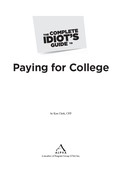Tax Tricks for Your Assets
There are a few other tax tricks out there that can indirectly lower your costs of a college education. Unlike the tax deductions and credits that directly reduce what you owe, these tax tricks for assets keep you from paying additional taxes when you tap certain assets to pay for college. Again, the tax rules on these can be a little complex at times, so my hope is that you’ll identify opportunities as you read through this section and seek out professional tax help if you’re not completely comfortable preparing your own taxes.
Section 529 and Coverdell ESA Withdrawals
If you were fortunate enough to be able to squirrel away some money in a Section 529 plan or Coverdell Education Savings Account (ESA), now is definitely the time to consider tapping those. As a general rule, these should be the first assets to go, especially before you tap into your retirement accounts, your own personal investments, or your home equity.
What makes tapping into these so attractive is that the IRS, as well as your state’s tax department, will allow you to withdraw the money without paying any tax on your accumulated gains, as long as the money is spent on college costs. That means that someone who originally deposited $1,000 that has now grown to $2,000 can permanently avoid paying tax on the gains if he withdraws the money and uses it to pay educational expenses.
One catch is that exclusion from tax on withdrawn gains can only be as large as your actual out-of-pocket expenditures for that year. This means you must subtract any scholarships, grants, or employer tuition assistance from your eligible costs to determine how much you can withdraw tax-free.
To be eligible for tax-free withdrawal, the money must be spent at an institution that is eligible to receive federal financial aid funds and the expenses must fall into one of the following categories:
• Tuition
• Fees
• Books
• Computers
• Equipment and supplies if required for enrollment
• Room and board, subject to certain limits (student must be more than half-time)
Waiving the Withdrawal Penalty on Retirement Accounts
If you decide you have to tap your retirement assets to help pay for college—something I generally advise against—you should know that you can do it penalty-free. Notice, I did not say tax-free necessarily, but penalty-free.
When it comes to pulling money out of retirement plans (as opposed to simply taking a loan against your balance), the 10 percent early withdrawal penalty for people under age 59½ is waived if the money is spent on qualified higher education expenses for themselves, their spouse, or their children. However, income taxes will still be due on all Traditional IRA withdrawals, as well as any gains withdrawn from Roth IRA accounts.
When withdrawing the money, be sure to indicate on the withdrawal form (there’s usually a box to check) that the withdrawal is for education purposes. This will ensure that you avoid the 10 percent penalty, although income tax might still be withheld. At the end of the year, you’ll receive a tax form from your IRA custodian that shows the withdrawal amount, which needs to be included on your tax return.
Income Exemption on U.S. Savings Bonds
Series EE and Series I savings bonds cashed in during any year when someone pays for college expenses for herself, a spouse, or children might be free from income taxes on her accumulated gain.
To be eligible, the person cashing in the bond must be at least 24 years old by the issue date listed on the face of the bond and the money must be spent at an institution eligible for federal financial aid. The funds can only be spent on tuition and fees, not on room and board.
..................Content has been hidden....................
You can't read the all page of ebook, please click here login for view all page.
